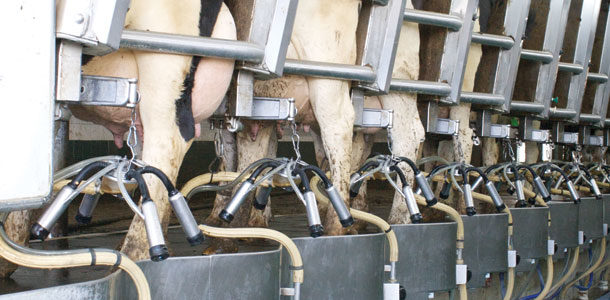Historically, when it came time to evaluate the mechanics of the milking system, an entire National Mastitis Council (NMC) vacuum and airflow test was completed. The amount of time that it takes to complete the full test could be an issue for some dairy operations, thus it is important to complete milking time tests that provide accurate information about vacuum stability during milking.
The NMC Procedures for Evaluating Vacuum Levels and Air Flow in Milking Systems publication was designed to evaluate the consistency of the milking system to maintain a claw vacuum and proper pulsation function within the intended range for the components of the milking system. Sections of those testing procedures are completed while milking cows (dynamic) and other sections are completed with vacuum and pulsation on but no milk flow (static).
The testing procedures are designed to evaluate a claw vacuum, irregular vacuum fluctuations and faulty pulsation. The guidelines provide a straightforward method for determining if the milking equipment is a risk for causing mastitis.
Is there value in only completing milking time tests to identify risks associated with milking machine-induced mastitis?
Evaluating claw vacuum during peak milk flow and graphing pulsators are two common tests that are often completed at milking time. Are there other tests that one may complete during milking to help identify issues related to vacuum stability? Is it possible to complete a milking unit fall-off test during milking and is there value in the results? The answer is yes. There is value in completing the fall-off test during milking versus not completing the fall-off test at all.
We are not implying that the complete procedures are unnecessary; however, do you need to test the capacity of the vacuum pump if a claw vacuum during peak milk flow is within range, the milk line vacuum is stable and a fall-off test passed? The information outlined below will provide adequate information to determine if the milking equipment is a risk for milking machine-induced mastitis.
Claw vacuum at peak milk flow
Guidelines for a claw vacuum during peak milk flow state that a claw vacuum range of 9.5 to 12.5 inches of mercury (inHg) is optimal. Most manufacturers of liners provide a desired claw vacuum range for optimal performance of the liner.
Pulsation phases
The other variables that are important to the liner function are the pulsation phases. When evaluating pulsators, emphasis is placed on the pulsation rate, ratio and milliseconds of the B and D phases. The desired pulsation phases depend upon the dairy operation's milking goals and liner design; however, a B phase of approximately 500 milliseconds and a D phase of 220 milliseconds are common within the dairy industry. Some pulsators should be evaluated under milkload to determine the true pulsation ratio and duration of each pulsation phase.
Increasing the claw vacuum and B phase of pulsation may lead to a shorter milking unit-on time; however, at the same time, the risk of firmness at the teat end and hyperkeratosis increases when vacuum levels are high. On the other hand, a low claw vacuum during peak milk flow may increase the milking unit-on time and increase the risk of squawks during milking. Thus, a delicate balance is necessary to milk cows out quickly and completely without putting them at risk for milking machine-induced mastitis. It is recommended that pulsators and claw vacuums be evaluated on a routine basis (multiple times a year to monthly – based on daily usage).
Vacuum fluctuation within the milk line
Maintaining constant vacuum levels with minimal vacuum fluctuation during milking is desired. Large, irregular vacuum fluctuations have been shown to increase somatic cell count (SCC) and clinical mastitis. Milk line vacuum fluctuation involves the components of airflow reserve or capacity, vacuum regulation and potential flooding of the milk line.
Vacuum stability is measured both in the milk line during milking and with a milking unit fall-off test. Vacuum fluctuation within the milk line occurs constantly given that there is milk (liquid) and air within the defined space of the milk line, which means that as milk fills within the milk line, the air is displaced, causing vacuum fluctuations during milking. Record the milk line vacuum at the milk inlet with the greatest milk flow for a period of 15 minutes during milking. If the average minus the minimum and maximum minus the average milk line vacuum recordings are less than 0.6 inHg, then the milk line vacuum is considered stable.
The ability of the vacuum regulator to maintain a constant vacuum when there are unplanned air leaks is determined by the completion of a milking unit fall-off test. Inadequate airflow reserve and/or improper vacuum regulation lead to large vacuum fluctuations during milking. Adequate airflow capacity leads to minimal vacuum fluctuation when there are unplanned air leaks – squawks or fall-offs, for example. Improper vacuum regulation occurs when the milk line vacuum decreases or increases by more than 0.6 inHg before returning to the operating vacuum of the milking system. The milking unit fall-off test will aid in determining if excessive irregular vacuum fluctuations in the milk line are caused by inadequate vacuum reserve (greater than 0.6 inHg) vacuum drop or improper vacuum regulation (greater than 0.6 inHg) undershoot or overshoot. The NMC vacuum and airflow procedures state that the fall-off test is to be completed as a dry or static test; however, the fall-off test may also be completed by monitoring vacuum at a point nearest the receiver while cows are milking. Constant and regular vacuum fluctuations, if minimized to less than 0.6 inHg, are of little concern as it relates to milking machine-induced mastitis.
The NMC vacuum and airflow testing procedures to evaluate claw vacuum and pulsation function should be completed on a routine basis. Every interaction between the liner and the teat is a risk for machine-induced mastitis. However, proper evaluation of the milking equipment function will allow you to determine if the milking equipment is a risk for machine-induced mastitis.
The full testing procedures should be completed once annually; however, routine analysis of claw vacuum, vacuum stability and graphing pulsators should be completed on a routine basis. Graphing pulsators, recording claw vacuum during peak milk flow, recording milk line vacuum and performing a fall-off test may provide enough information to determine if the function of the milking equipment is a risk for milking machine-induced mastitis.












